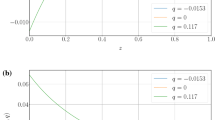Abstract
The redshift-distance modulus relation, the Hubble Diagram, derived from Cosmological General Relativity has been extended to arbitrarily large redshifts. Numerical methods were employed and a density function was found that results in a valid solution of the field equations at all redshifts. The extension has been compared to 302 type Ia supernova data as well as to 69 Gamma-ray burst data. The latter however do not truly represent a ‘standard candle’ as the derived distance moduli are not independent of the cosmology used. Nevertheless the analysis shows a good fit can be achieved without the need to assume the existence of dark matter.
The Carmelian theory is also shown to describe a universe that is always spatially flat. This results from the underlying assumption of the energy density of a cosmological constant ΩΛ=1, the result of vacuum energy. The curvature of the universe is described by a spacevelocity metric where the energy content of the curvature at any epoch is Ω K =ΩΛ−Ω=1−Ω, where Ω is the matter density of the universe. Hence the total density is always Ω K +Ω=1.
Similar content being viewed by others
References
Astier, P., et al.: The supernova legacy survey: Measurement of Ω M , ΩΛ and w from the first year data set. Astron. Astrophys. 447(1), 31–48 (2006)
Carmeli, M.: Cosmological Special Relativity. World Scientific, Singapore (2002)
Carmeli, M.: Cosmological Special Relativity, p. 23. World Scientific, Singapore (2002)
Carmeli, M.: Cosmological Relativity. World Scientific, Singapore (2006)
Carmeli, M.: Accelerating Universe: Theory versus experiment. arXiv: astro-ph/0205396 (2002)
Carmeli, M., Hartnett, J.G., Oliveira, F.J.: The cosmic time in terms of the redshift. Found. Phys. Lett. 19(3), 277–283 (2006), arXiv:gr-qc/0506079
Fukugita, M., Hogan, C.J., Peebles, P.J.E.: The cosmic baryon budget. Astrophys. J. 503, 518–530 (1998)
Hartnett, J.G.: The distance modulus determined from Carmeli’s cosmology fits the accelerating universe data of the high-redshift type Ia supernovae without dark matter. Found. Phys. 36(6), 839–861 (2006), arXiv:astro-ph/0501526
Hartnett, J.G.: Spiral galaxy rotation curves determined from Carmelian general relativity. Int. J. Theor. Phys. 45(11), 2147–2165 (2006), arXiv:astro-ph/0511756
Hartnett, J.G., Oliveira, F.J.: Luminosity distance, angular size and surface brightness in Cosmological General Relativity. Found. Phys. 37(3), 446–454 (2007), arXiv: astro-ph/0603500
Gemelli, G.: Particle production in 5-dimensional Cosmological Relativity. Int. J. Theor. Phys. 45(12), 2261–2269 (2006)
Knop, R.A., et al.: New constraints on Ω M , ΩΛ and w from an independent set of 11 high-redshift supernovae observed with the Hubble Space Telescope. Astrophys. J. 598, 102–137 (2003)
Oliveira, F.J., Hartnett, J.G.: Carmeli’s cosmology fits data for an accelerating and decelerating universe without dark matter or dark energy. Found. Phys. Lett. 19(6), 519–535 (2006), arXiv: astro-ph/0603500
Perlmutter, S., et al.: Measurements of the cosmological parameters Ω and Λ from the first seven supernovae at z>0.35. Astrophys. J. 483, 565–581 (1997)
Riess, A.G., Filippenko, A.V., Challis, P., Clocchiatti, A., Diercks, A.: Observational evidence from supernovae for an accelerating universe and a cosmological constant. Astron. J. 116, 1009–1038 (1998)
Riess, A.G., et al.: Type Ia supernovae discoveries at z>1 from the Hubble Space Telescope: Evidence for past deceleration and constraints on dark energy evolution. Astrophys. J. 607, 665–687 (2004)
Schaefer, B.E.: The Hubble diagram to redshift >6 from 69 Gamma-Ray bursts. Astrophys. J. 660, 16–46 (2007)
Author information
Authors and Affiliations
Corresponding author
Rights and permissions
About this article
Cite this article
Hartnett, J.G. Extending the Redshift-Distance Relation in Cosmological General Relativity to Higher Redshifts. Found Phys 38, 201–215 (2008). https://doi.org/10.1007/s10701-007-9198-5
Received:
Accepted:
Published:
Issue Date:
DOI: https://doi.org/10.1007/s10701-007-9198-5




